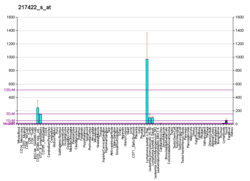CD22
| CD22 | |||||||||||||||||
|---|---|---|---|---|---|---|---|---|---|---|---|---|---|---|---|---|---|
| Identifiers | |||||||||||||||||
| Aliases | CD22, SIGLEC-2, SIGLEC2, CD22 molecule | ||||||||||||||||
| External IDs | OMIM: 107266 MGI: 88322 HomoloGene: 31052 GeneCards: CD22 | ||||||||||||||||
| |||||||||||||||||
| RNA expression pattern | |||||||||||||||||
   | |||||||||||||||||
| More reference expression data | |||||||||||||||||
| Orthologs | |||||||||||||||||
| Species | Human | Mouse | |||||||||||||||
| Entrez | |||||||||||||||||
| Ensembl | |||||||||||||||||
| UniProt | |||||||||||||||||
| RefSeq (mRNA) |
| ||||||||||||||||
| RefSeq (protein) | |||||||||||||||||
| Location (UCSC) | Chr 19: 35.32 – 35.35 Mb | Chr 7: 30.87 – 30.88 Mb | |||||||||||||||
| PubMed search | [1] | [2] | |||||||||||||||
| Wikidata | |||||||||||||||||
| |||||||||||||||||
CD22, or cluster of differentiation-22, is a molecule belonging to the SIGLEC family of lectins.[3] It is found on the surface of mature B cells and to a lesser extent on some immature B cells. Generally speaking, CD22 is a regulatory molecule that prevents the overactivation of the immune system and the development of autoimmune diseases.[4]
CD22 is a sugar binding transmembrane protein, which specifically binds sialic acid with an immunoglobulin (Ig) domain located at its N-terminus. The presence of Ig domains makes CD22 a member of the immunoglobulin superfamily. CD22 functions as an inhibitory receptor for B cell receptor (BCR) signaling. It is also involved in the B cell trafficking to Peyer's patches in mice.[5]
An immunotoxin, BL22, that targets this receptor is being tested at the NIH.[6]
Interactions
CD22 has been shown to interact with Grb2,[7][8] PTPN6,[8][9][10][11][12] LYN,[7][10] SHC1[7] and INPP5D.[7]
References
- ↑ "Human PubMed Reference:".
- ↑ "Mouse PubMed Reference:".
- ↑ Crocker PR, et al. (February 1998). "Siglecs: a family of sialic-acid binding lectins". Glycobiology. 8 (2): v. PMID 9498912. doi:10.1093/glycob/8.2.0.
- ↑ Hatta; et al. (1999). "Identification of the gene variations in human CD22". Immunogenetics. 49 (4): 280–286. doi:10.1007/s002510050494.
- ↑ Lee M, Kiefel H, LaJevic MD, Macauley MS, Kawashima H, O'Hara E, Pan J, Paulson JC, Butcher EC (October 2014). "Transcriptional programs of lymphoid tissue capillary and high endothelium reveal control mechanisms for lymphocyte homing". Nature Immunology. 15 (10): 982–95. PMC 4222088
 . PMID 25173345. doi:10.1038/ni.2983.
. PMID 25173345. doi:10.1038/ni.2983. - ↑ "BL22 Immunotoxin in Treating Patients Previously Treated With Cladribine for Hairy Cell Leukemia". ClinicalTrials.gov - U.S. National Institutes of Health. Retrieved 2008-02-19.
- 1 2 3 4 Poe JC, Fujimoto M, Jansen PJ, Miller AS, Tedder TF (June 2000). "CD22 forms a quaternary complex with SHIP, Grb2, and Shc. A pathway for regulation of B lymphocyte antigen receptor-induced calcium flux". The Journal of Biological Chemistry. 275 (23): 17420–7. PMID 10748054. doi:10.1074/jbc.M001892200.
- 1 2 Otipoby KL, Draves KE, Clark EA (November 2001). "CD22 regulates B cell receptor-mediated signals via two domains that independently recruit Grb2 and SHP-1". The Journal of Biological Chemistry. 276 (47): 44315–22. PMID 11551923. doi:10.1074/jbc.M105446200.
- ↑ Blasioli J, Paust S, Thomas ML (January 1999). "Definition of the sites of interaction between the protein tyrosine phosphatase SHP-1 and CD22". The Journal of Biological Chemistry. 274 (4): 2303–7. PMID 9890995. doi:10.1074/jbc.274.4.2303.
- 1 2 Greer SF, Justement LB (May 1999). "CD45 regulates tyrosine phosphorylation of CD22 and its association with the protein tyrosine phosphatase SHP-1". Journal of Immunology. 162 (9): 5278–86. PMID 10228003.
- ↑ Law CL, Sidorenko SP, Chandran KA, Zhao Z, Shen SH, Fischer EH, Clark EA (February 1996). "CD22 associates with protein tyrosine phosphatase 1C, Syk, and phospholipase C-gamma(1) upon B cell activation". The Journal of Experimental Medicine. 183 (2): 547–60. PMC 2192439
 . PMID 8627166. doi:10.1084/jem.183.2.547.
. PMID 8627166. doi:10.1084/jem.183.2.547. - ↑ Adachi T, Wienands J, Wakabayashi C, Yakura H, Reth M, Tsubata T (July 2001). "SHP-1 requires inhibitory co-receptors to down-modulate B cell antigen receptor-mediated phosphorylation of cellular substrates". The Journal of Biological Chemistry. 276 (28): 26648–55. PMID 11356834. doi:10.1074/jbc.M100997200.
External links
- CD22 Antigen at the US National Library of Medicine Medical Subject Headings (MeSH)
External links
- Human CD22 genome location and CD22 gene details page in the UCSC Genome Browser.